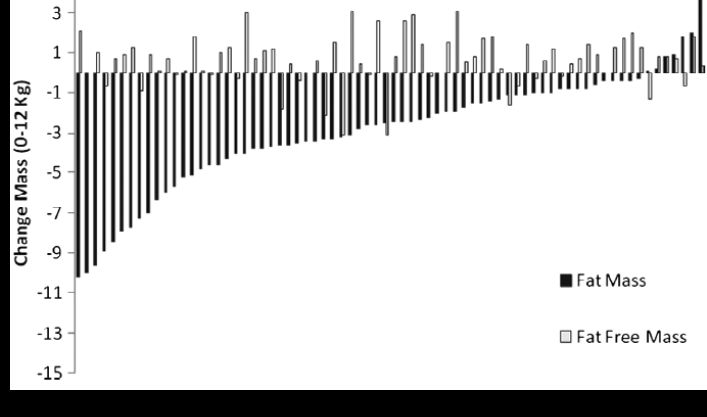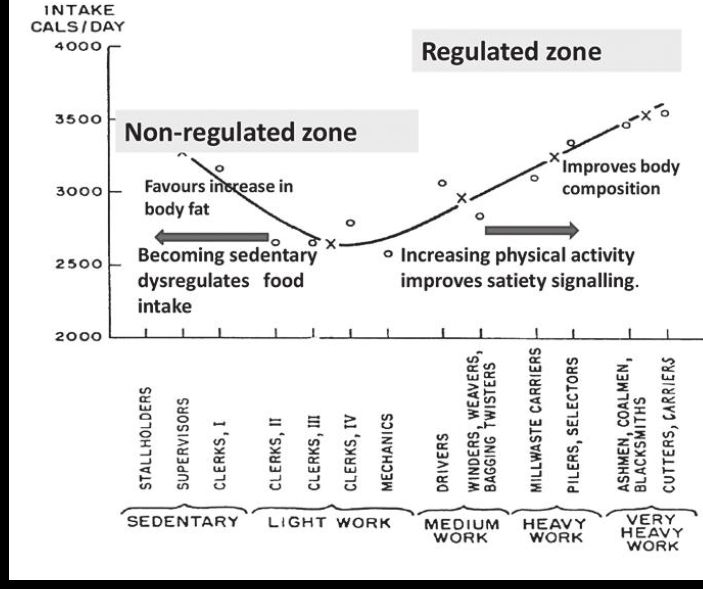
Physiology News Magazine
Appetite control and exercise: not just energy-in and energy-out
‘the differences between the intakes of food must originate in the differences in energy expenditure’ (Edholm et al., 1955).
Features
Appetite control and exercise: not just energy-in and energy-out
‘the differences between the intakes of food must originate in the differences in energy expenditure’ (Edholm et al., 1955).
Features
John Blundell
Chair of PsychoBiology, University of Leeds, UK
https://doi.org/10.36866/pn.96.21
Ideas proposed over 50 years ago but left neglected until recently are defining a revitalised perspective of energy balance (EB) in relation to body weight, and the contribution of behaviour to the physiology of energy balance. Edholm and co-worl (1955, 1977) sought to establish a fundamental relationship between energy expenditure (EE) and energy intake (EI). Behind this was ‘the desire to find out more about the mechanisms which relate intake to expenditure – what regulates appetite, in fact’ (Edholm et al., 1955, p286). Edholm’s views implied an impact of physiology on behaviour and an influence of energy expenditure on appetite control. Strangely this view was ignored and the general approach to the issue was largely abandoned. However, just because Edholm’s views have been overlooked does not mean that they were wrong.
’the late Henry Taylor favoured a model that linked energy intake to expenditure in a J shaped curve (personal communication, late 1970s). The first part of his concept was that energy intake was in exact homeostasis with energy expenditure under conditions of high energy expenditure. The second part was that there is a failure of homeostasis in sedentary lifestyles because of its accompanying low energy expenditure. He postulated that bodily signals go awry in sedentary lifestyles; when a person does no physical work, the body will not recognize that it is being overfed. Sedentary persons may lose the innate ability to compensate for inactivity by reducing their eating.’-Cited by Jacobs (2006), p1234.
The neglect of Edholm’s views left a void which was filled by a simple mechanical approach to energy balance and body weight. This is reflected in the common depiction of energy balance as a set of kitchen scales with food on one pan and physical activity on the other; whichever has the highest value determines whether there will be a positive or negative energy balance. This model is false and gives a misleading impression of how the system works. The EB approach to appetite control and obesity is not just a case of energy-in and energy-out. The kitchen scale model represents a static view of EB and has provided a widely used rule of thumb that a change in EB of 8000 kcal will lead to a 1 kg change in body weight. This rule is false and leads to wildly optimistic expectations of weight change. Using a dynamic model of energy balance (Hall et al., 2011; Thomas et al., 2013) gives recognition to a physiological regulated system that actively readjusts behaviour in response to challenges, and leads to more realistic computed changes in body weight.
A regulated physiological system resonates with demonstrations that alterations in physical activity influence appetite control, and that changes in food consumption (diet) adjust behavioural activity (Stubbs et al., 2004). Changes in NEAT (non-exercise activity thermogenesis) illustrate how the effects of mandatory overconsumption are offset by increases in spontaneous activity (Levine et al., 1999). Conversely, obese people given supervised and measured sessions of physical activity (five 1 hour sessions per week for 12 weeks) show clear changes in appetite control; these include an increase in fasting (early morning) hunger and an improvement in the strength of post-meal satiety signalling (King et al., 2009). Together these adjustments influence the overall EI in response to the imposed EE and partly determine the observed changes in body composition. An important feature of these types of manipulations is the very large individual variability in the response to a challenge. People do not all respond in the same way to overconsumption or to imposed exercise. The average response of a group of people is not very informative. For example when exercise sessions are monitored to eliminate the possibility of non-compliance (usually a big factor in exercise studies), about 15–25% of participants gain weight (Fig. 1).
Importantly fat mass is significantly reduced along with waist circumference (King et al., 2008; Caudwell et al., 2013) and any weight gain is usually (but not invariably) almost entirely fat-free mass (FFM). This action of exercise on body composition is one reason to expect that the adaptive response to physical activity energy expenditure involves both metabolism (resting metabolic rate) and behaviour (food intake) (Hopkins et al., 2014). This again illustrates why a simple rule of calories to weight change is not plausible.


Interestingly, this wide variability in body weight (and body composition) in response to exercise stimulates thinking about the link between energy expenditure and appetite (as Edholm suggested). First, as noted by the late Henry Taylor (see box), the control over appetite (food consumption) depends upon the level of energy expenditure. As reported above, making people active increases the strength of satiety signalling. Other studies have shown that sedentariness (reflected in low leisure time physical activity) is associated with weak satiety (especially to fat) and to the trait of disinhibition, which is a marker for susceptibility to overeating (Blundell et al., 2005). Together these findings map onto the picture of calorie intake and physical work proposed by Jean Mayer (a contemporary of Edholm). The inverted-U function (Fig. 2) reported a paradoxical increase in calorie intake at low levels of energy expenditure (Mayer et al., 1956). A recent interpretation of this figure has identified ‘regulated’ and a ‘non-regulated’ zones of appetite control corresponding to the background level of physical activity EE (Blundell, 2011).
Secondly, these studies draw attention to distinct effects on appetite arising from different components of the energy budget. The observation that the size of meals and daily EI are both associated with the amount of FFM and not with fat mass (FM) or BMI, draws attention to the role of body composition in determining food intake (Blundell et al., 2011). In turn the fact that the variance in resting metabolic rate (RMR) is determined largely by FFM (about 60%) whereas FM only contributes about 7%, suggests that RMR could be a driver of the motivation to eat and of EI (Caudwell et al., 2013). This formulation indicates that the ‘adipocentric’ concept of food intake control is incomplete and should be amended to include a role for the action of fat-free mass (Blundell et al., 2012). How should these findings be interpreted? To describe the operations in rather crude terms, the energy expenditure from RMR applies a uniform and tonic pressure on appetite whereas the energy expenditure from physical activity is more complex and unpredictable (at the level of the person) and depends on changes in body composition, gastrointestinal peptides and individual variability in biological responsiveness. Energy balance is not just a case on energy-in and energy-out.
Over the next decade there are great opportunities for research to examine in more detail the mechanisms through which physical activity improves satiety signalling, and the physiological processes through which sedentariness undermines the homeostatic regulation of appetite.
Acknowledgements
The research from the Leeds group described above was supported by BBSRC grant numbers BBS/B/05079 and BB/G005524/1, and the European Union Seventh Framework Programme (FP7/2007-2013) under grant agreement number 266408. Ethical permission given by the Leeds NHS Research Ethics Committee number 09/H1307/7. Projects were carried out under international standard trials approval (ISRCTN47291569).
References
Blundell J, Stubbs J, Golding C, Croden F, Alam R, Whybrow S & Lawton C (2005). Resistance and Susceptibility to weight gain: Individual variability in response to a high fat diet. Physiol Behav 86, 614–622.
Blundell J (2011). Physical activity and appetite control: can we close the energy gap? Nutr Bull 36, 356–366.
Blundell JE, Caudwell P, Gibbons C, Hopkins M, Näslund E, King NA, et al. (2011). Body composition and appetite: fat-free mass (but not fat mass or BMI) is positively associated with self-determined meal size and daily energy intake in humans. Bri J Nutr 107, 445–449.
Blundell JE, Caudwell P, Gibbons C, Hopkins M, Naslund E, King N, et al. (2012). Role of resting metabolic rate and energy expenditure in hunger and appetite control: a new formulation. Dis Model Mech 5, 608–613.
Caudwell P, Gibbons C, Hopkins M, King N, Finlayson G & Blundell J (2013). No Sex Difference in Body Fat in Response to Supervised and Measured Exercise. Med Sci Sports Exerc 351–358 10.1249/MSS.0b013e31826ced79.
Caudwell P, Finlayson G, Gibbons C, Hopkins M, King N, Naslund E, et al. (2013). Resting metabolic rate is associated with hunger, self-determined meal size, and daily energy intake and may represent a marker for appetite. Am J Clin Nutr 97, 7–14.
Edholm OG, Fletcher JG, Widdowson EM & McCance RA (1955). The Energy Expenditure and Food Intake of Individual Men. Brit J Nutr 9, 286–300.
Edholm O (1977). Energy balance in man. Studies carried out by the Division of Human Physiology, National Institute for Medical Research. J Hum Nutr 31, 413–431.
Hall KD, Sacks G, Chandramohan D, Chow CC, Wang YC, Gortmaker SL, et al. (2011). Quantification of the effect of energy imbalance on bodyweight. Lancet 378, 826–837
Hopkins M, Gibbons C, Caudwell P, Hellstrom P, Naslund E, King N, Finlayson G & Blundell J (2014). The adaptive metabolic response to exercise-induced weight loss influences both energy expenditure and energy intake. Eur J Clin Nutr 68, 581–586
Jacobs DR (2006). Fast food and sedentary lifestyle: a combination that leads to obesity. Am J Clin Nutr 83, 189–190.
King NA, Hopkins M, Caudwell P, Stubbs R & Blundell JE (2008). Individual variability following 12 weeks of supervised exercise: identification and characterization of compensation for exercise-induced weight loss. Int J Obes 32, 177–184.
King N, Caudwell P, Hopkins M, Stubbs J, Naslund E & Blundell J (2009). Dual-process action of exercise on appetite control: increase in orexigenic drive but improvement in meal-induced satiety. Am J Clin Nutr 90, 921–927.
Levine JA, Eberhardt NL & Jensen MD (1999). Role of nonexercise activity thermogenesis in resistance to fat gain in humans. Science 283, 212–214.
Mayer J, Roy P & Mitra K (1956). Relation between caloric intake, body weight, and physical work: studies in an industrial male population in West Bengal. Am J Clin Nutr 4, 169–175.
Stubbs R, Hughes D, Johnstone A, Whybrow S, Horgan G, King N, et al. (2004). Rate and extent of compensatory changes in energy intake and expenditure in response to altered exercise and diet composition in humans. Am J Physiol Integr Comp Physiol 286, R350–R358
Thomas D, Martin C, Lettieri S, Bredlau C, Kaiser K, Church T, Bouchard C & Heymsfield S (2013). Can a weight loss of one pound a week be achieved with a 3500-kcal deficit? Commentary on a commonly accepted rule. Int J Obes 37, 1611–1613.
